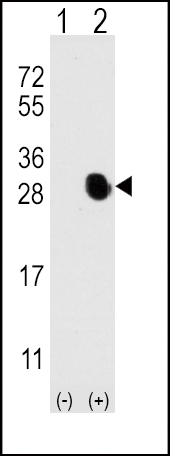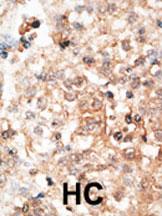Osteocalcin Antibody (N-term)
Purified Rabbit Polyclonal Antibody (Pab)
- 产品详情
- 实验流程
- 背景知识
Application
| WB, IHC-P, E |
|---|---|
| Primary Accession | P02818 |
| Other Accession | NP_954642 |
| Reactivity | Human |
| Host | Rabbit |
| Clonality | Polyclonal |
| Isotype | Rabbit IgG |
| Calculated MW | 10963 Da |
| Antigen Region | 2-32 aa |
| Gene ID | 632 |
|---|---|
| Other Names | Osteocalcin, Bone Gla protein, BGP, Gamma-carboxyglutamic acid-containing protein, BGLAP |
| Target/Specificity | This Osteocalcin antibody is generated from rabbits immunized with a KLH conjugated synthetic peptide between 2-32 amino acids from the N-terminal region of human Osteocalcin. |
| Dilution | WB~~1:1000 IHC-P~~1:100~500 E~~Use at an assay dependent concentration. |
| Format | Purified polyclonal antibody supplied in PBS with 0.09% (W/V) sodium azide. This antibody is prepared by Saturated Ammonium Sulfate (SAS) precipitation followed by dialysis against PBS. |
| Storage | Maintain refrigerated at 2-8°C for up to 2 weeks. For long term storage store at -20°C in small aliquots to prevent freeze-thaw cycles. |
| Precautions | Osteocalcin Antibody (N-term) is for research use only and not for use in diagnostic or therapeutic procedures. |
| Name | BGLAP |
|---|---|
| Function | Bone protein that constitutes 1-2% of the total bone protein, and which acts as a negative regulator of bone formation (PubMed:3019668, PubMed:6967872). Functions to limit bone formation without impairing bone resorption or mineralization (By similarity). It binds strongly to apatite and calcium (PubMed:6967872). |
| Cellular Location | Secreted. |
For Research Use Only. Not For Use In Diagnostic Procedures.
Provided below are standard protocols that you may find useful for product applications.
BACKGROUND
Prior to the formation of calcified bone, noncollagenous proteins form in the extracellular bone matrix. Gamma-carboxyglutamic acid residues are formed by vitamin K, vitamin-D regulated calcium binding proteins containing residues of Gla. These residues are essential for the binding of calcium and constitue 1-2% of total bone protein. Osteocalcin itself binds strongly to apatite and calcium. Production of osteocalcin is expressed late in normal bone development and is characteristic of mature osteoblasts. Regular osteocalcin production has been shown to be linked to the p53 tumor suppressor gene. The p53 gene undergoes rearrangement in a high percentage of osteosarcomas, resulting in loss of its expression. The loss of p53 regulation inhibits further osteocalcin production. The absence of end-point differentiation in bone due to p53 rearrangements and lack of osteocalcin production may contribute to the maintenance of the tumorigenic phenotype in osteosarcomas.
REFERENCES
Yamada, Y., et al., J. Clin. Endocrinol. Metab. 88(7):3372-3378 (2003). Gronthos, S., et al., J. Bone Miner. Res. 18(4):716-722 (2003). Yousfi, M., et al., Biochem. Biophys. Res. Commun. 297(3):641-644 (2002). Willis, D.M., et al., J. Biol. Chem. 277(40):37280-37291 (2002). Viereck, V., et al., J. Cell. Biochem. 86(2):348-356 (2002).
终于等到您。ABCEPTA(百远生物)抗体产品。
点击下方“我要评价 ”按钮提交您的反馈信息,您的反馈和评价是我们最宝贵的财富之一,
我们将在1-3个工作日内处理您的反馈信息。
如有疑问,联系:0512-88856768 tech-china@abcepta.com.























 癌症的基本特征包括细胞增殖、血管生成、迁移、凋亡逃避机制和细胞永生等。找到癌症发生过程中这些通路的关键标记物和对应的抗体用于检测至关重要。
癌症的基本特征包括细胞增殖、血管生成、迁移、凋亡逃避机制和细胞永生等。找到癌症发生过程中这些通路的关键标记物和对应的抗体用于检测至关重要。 为您推荐一个泛素化位点预测神器——泛素化分析工具,可以为您的蛋白的泛素化位点作出预测和评分。
为您推荐一个泛素化位点预测神器——泛素化分析工具,可以为您的蛋白的泛素化位点作出预测和评分。 细胞自噬受体图形绘图工具为你的蛋白的细胞受体结合位点作出预测和评分,识别结合到自噬通路中的蛋白是非常重要的,便于让我们理解自噬在正常生理、病理过程中的作用,如发育、细胞分化、神经退化性疾病、压力条件下、感染和癌症。
细胞自噬受体图形绘图工具为你的蛋白的细胞受体结合位点作出预测和评分,识别结合到自噬通路中的蛋白是非常重要的,便于让我们理解自噬在正常生理、病理过程中的作用,如发育、细胞分化、神经退化性疾病、压力条件下、感染和癌症。







